The WaveAce series oscilloscopes from Teledyne LeCroy are LeCroy’s answer to low-cost entry level oscilloscopes. They are available as 2- or 4-channel versions and with different bandwidths (40 – 300 MHz). LeCroy’s representative for my region, T&M Instruments [1], shipped a LecCroy WaveAce 1002 (2-channel, 60 MHz) my way to have a look at it. Let’s check it out!
The WaveAce 1002 is a 2-channel DSO with 60 MHz bandwidth, a sample rate of 1 GS/s with just one channel in use or 500 MS/s if both channels are in use, and a memory depth of 2 Mpt/Ch with just one channel in use or 1 Mpt/Ch if both channels are used. The display of the scope is a 7.0 TFT-LCD with a screen resolution of 480 x 234 pixels (QVGA).
For more details and tech-specs, visit the manufacturer’s webpage for the AceWave series [2] and the WaveAce 1002 [3].
The scope makes a very solid impression. The menus are self-explanatory and very well structured. I didn’t need to look at the manual or the built-in help functions at any point to find exactly what I was looking for.
I particularly like that LeCroy didn’t simply reinvent the wheel and actually added some value to their entry-level scopes. The WaveAce scopes come with neat functions that are usually in the domain of upper intermediate level scopes.
One of those great features is a mask testing feature. A mask of a signal with acceptable tolerance can be loaded into the scope. The scope then compares the input signal with the mask and indicates whether or not the signal is within the mask or not.
Not only does the scope give a visual pass / fail indication, there’s even a dedicated pass / fail BNC connector on the back of the scope. That way, the WaveAce scope can easily be used in automated testing quality control set-ups. The BNC’s output voltage can be selected to be active on fail or active on pass.
There’s no special software needed to set up the mask. The oscilloscope has an extra menu dedicated to creating a mask.
Another great feature that comes in handy is the zoom function. A common problem with a regular oscilloscope is that one can either set the time base to get a good overview of the whole signal or one can zoom into the signal but usually not both at the same time. LeCroy thought about this problem and implemented a zoom function that enables one to zoom into a section of the signal using a split screen feature without losing the original view of the signal. Sounds confusing? Take a look:
A similar split screen can be used while viewing a Fast Fourier Transform (FFT) of a signal. A mixed domain view allows the signal to be viewed in the time domain (top) and in the frequency domain (bottom) at the same time.
All screenshots I am using in this review have been generated by the scope itself, by the way. All one needs to do to save a screenshot on an external storage device is to plug the storage device into the USB port on the front panel of the scope and press the ‘Print’ button. No set-up, nothing. The pictures generated are Bitmaps with 480 by 234 pixels.
If you have ever bought an inexpensive entry level DSO, you know that bandwidth is often an issue. The manufacturers of low-cost devices are really stretching the bandwidth data. The Owon PDS5022T for instance doesn’t even get close to its alleged 25 MHz. So how does the LeCroy measure up?
I wanted to measure the rise time of a pulse generator with my demo scope and determined the approximate bandwidth by dividing 0.35 by the rise time. It turns out that none of my signal generators are capable of putting out a signal with the needed rise time for 60 MHz (5.8 ns). But no worries, I will build a pulse generator soon and add the result here.
The actual rise time mentioned in the datasheet is actually a bit lower (5 ns). Therefore I am tempted to say that the 60 MHz rating is a rather conservative value with a bit of safety buffer.
UPDATE (10/24/2012): As promised, I measured the rise-time of the scope to determine the factual bandwidth. The rise time I measured is 3.6 ns, which is better than what the datasheet promises. Assuming a Gaussian response, the scope’s bandwidth would be close to 100 MHz (0.35 / 0.0000000036). For a flat response we’d get a bandwidth of around 120 MHz (0.44 / 0.0000000036). In either case, this is way beyond the 60 MHz the scope is rated for.
With an antenna attached to Channel 1 input, I could capture a signal of my amateur radio transceiver on 146.520 MHz without a problem. Of course the time base doesn’t allow closer zoom on the signal and the amplitude is probably off. Nonetheless, it shows that the scope is definitely usable for a quick look at signals way beyond the oscilloscope’s bandwidth rating.
Like all WaveAce oscilloscopes, the WaveAce 1002 has a bandwidth limit filter. If this feature is activated, the bandwith of the scope is limited to 20 MHz. By limiting the bandwidth, the noise that sometimes appears on the displayed waveform can be reduced. This results in a cleaner signal display.
The scope offers a variety of measurement parameters. The following parameters can be measured: Amplitude, Average, Base, Burst Width, Cyclical RMS, +Duty Cycle, -Duty Cycle, Fall Time, Frequency, Max, Mean, Min, Overshoot, Peak-Peak, Period, Phase, Preshoot, Rise Time, RMS, Top, +Width, -Width, First Rising-Rising, First Rising-Falling, First Falling-Rising, First Falling-Falling, Last Rising-Rising, Last Rising-Falling, Last Falling-Rising, Last Falling-Falling.
An additional math track allows to display either the result of the mathematical functions add, subtract, multiply, and divide of channel 1 and 2. Additionally, a Fast Fourier Transform (FFT) of the signal on either channel 1 or 2 can be displayed.
With just 163 mm x 313 mm x 115.8 mm (6.42″ x 12.32″ x 4.6″) and a total weight of 2.78 kg (6.1 lbs), the scope is very compact. Thanks to its wide power supply range of 100 – 240 VAC and a frequency range of 45 Hz to 440 Hz, this scope is excellent for service all around the world. Thanks to the wide frequency range, the scope can even be used in special 400 Hz mains supply environments such as on board of an aircraft and in special military applications (MIL-STD-704).
The list price of the WaveAce 1002 is $990.00 [3]. For a real LeCroy, this is an excellent price / performance ratio.
Links and Sources:
[1] T&M Instruments: http://www.tandm.net/
[2] WaveAce 1000 and 2000 Oscilloscopes, LeCroy http://teledynelecroy.com/
[3] WaveAce 1002 Oscilloscope, LeCroy http://teledynelecroy.com/
Westerhold, S. (2012), "Review: Teledyne LeCroy WaveAce 1002 – Digital Storage Oscilloscope". Baltic Lab High Frequency Projects Blog. ISSN (Online): 2751-8140., https://baltic-lab.com/2012/10/review-leccroy-waveace-1002-digital-storage-oscilloscope/, (accessed: November 17, 2025).
- WebP-Images without Plugin - January 14, 2025
- Firewall Rules with (dynamic) DNS Hostname - January 14, 2025
- Restoring proxied visitor IPs from Cloudflare - December 26, 2024
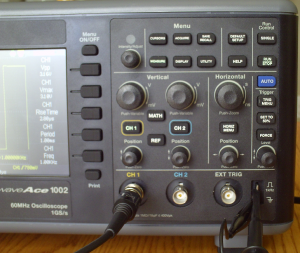


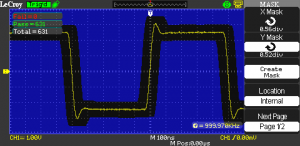
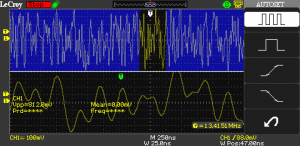
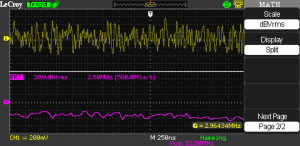
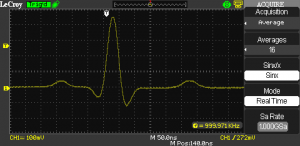
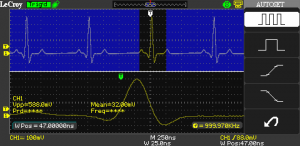
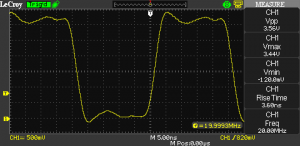
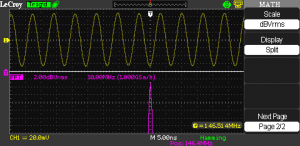
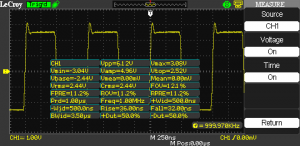
Closer look at a Direct Sequence Spread Spectrum Signal | KF5OBS /IP
[…] Review: Teledyne LeCroy WaveAce 1002 – Digital Storage Oscilloscope […]
Review: Abracon ABFT Frequency Translators | KF5OBS /IP
[…] datasheet claims. But no need to worry — what’s displayed here is the rise time of the LeCroy WaveAce 1002 as shown in my review. I simply do not have a scope that is capable of dealing with 1.2 ns rise time. Output of the […]
Steve sandler
Did you measure the rise time with a probe? Please see my recent article in test and measurement world. The rule of thumb 0.95 is now closer to 1. We used the 640z in our example.
KF5OBS
Steve, I did use the 300 MHz passive probe that came with the scope. If I find the time later, I will look at your article. However, for this article the exact value did not matter as I solely wanted to see whether or not the WaveAce meets the promised 60 MHz. Therefore, I wanted to be safe and assume a smaller value.
Here’s the link to Steve’s article: http://www.tmworld.com/design/characterization/4394475/Sharpen-rising-and-falling-edges
robert
Hey, I hope this device will serve you well.
Just out of curiosity, if you have the time, could you check if some of the bugs of the previous models have been fixed?
Here’s a description + some pics / videos:
http://www.eevblog.com/forum/product-reviews-photos-and-discussion/dso-triggering-issues/
http://www.eevblog.com/forum/product-reviews-photos-and-discussion/more-waveace224-issues!/
KF5OBS
Robert, I will investigate and post back what my findings are. Thank you for supplying the links.